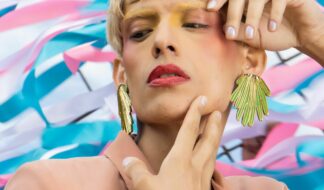By Judith Cookis Rubens
GRAND RAPIDS –
Today's girl groups have big-name designers lining up to dress them for concerts and appearances, but back in the early '60s, the trio that would become The Supremes fashioned their own gowns.
The original three – Diana Ross, Mary Wilson and Florence Ballard – were then just teens from Detroit's Brewster housing projects.
"Living in the projects in high school, Diane (Diana Ross) and I sewed our first gowns together," says original Supremes member Wilson, in the text that accompanies a traveling exhibit of the group's most recognizable, glamorous gowns.
In "The Supremes Reflections: The Mary Wilson Supreme Legacy Collection," now through Jan. 6, 2008 at the Grand Rapids Public Museum, nearly 50 gowns – plus group memorabilia and video clips – remind audiences of The Supremes' influence on fashion, pop culture and music history.
"The Supremes didn't happen in a vacuum. The context is that changing time of the 1960s," said Marilyn Merdzinski, the museum's curator of collections and preservation.
Wilson, now 63, was the one constant member throughout the group's later incarnations. As such, she kept most of the gowns worn on TV specials, album covers and in live performances. Wilson, working with Cleveland's Rock and Roll Hall of Fame and Museum, agreed to a full-scale display in Cleveland in 2004.
To give the gowns context, the Hall of Fame added photos, group memorabilia and text panels to explain the group's career timeline, give background on other early girl groups, and cover the history of Berry Gordy's Motown Records. Other panels recap the '60s struggle for racial equality – a divide that some believe was eased, in part, because performers like The Supremes helped integrate the country with their music and glamorous appeal.
"Berry Gordy's vision was to create stars who transcended color," said Howard Kramer, the Rock and Roll Hall of Fame's curatorial director, who worked on the original exhibit. "The Supremes could play the state fairs as well as the ritziest nightclubs or the black-oriented clubs."
The Supremes exhibit hasn't traveled widely in the United States. After its Cleveland debut, it came to the Detroit Historical Museum in 2005, with later stops in Albany and Long Island, N.Y. But Grand Rapids will be its final U.S. stop before heading to Great Britain's Victoria and Albert Museum early next year.
It was a bit of a coup for the Grand Rapids Public Museum – one of the oldest history museums in the United States, but one that has seen recent upheavals in leadership and funding. In 2006, the museum switched to non-profit status and is no longer run by the city.
The museum dedicates 3,000 square feet to the 50 colorful sequined and feathered gowns. They range from the simple black sheath dresses of the girls' Primettes days, to pink-feathered Bob Mackie designs from 1969, to the '70s pink bellbottom jumpsuits and matching vests worn on "Soul Train." The group's Top 40 hits can be heard overhead, while a TV plays video clips of the trio's many performances on the Ed Sullivan Show.
Another corner re-creates a Supremes dressing room, complete with wigs, clothing, shoes and costume jewelry from Wilson's own collection.
Even back then, marketing an image was big business. You'll notice items from The Supremes Wig Collection, as well as a wrapper from a loaf of "The Supremes Special Formula White Bread."
This is Kramer's favorite item in the collection. "It possesses no small amount of irony for these three girls from the projects," he said, "but it gives you an idea of how important they were to people."









